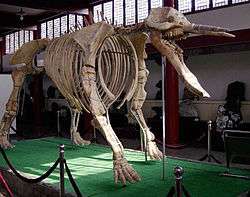Amebelodontidae
| Amebelodont Temporal range: 16–2.5 Ma | |
|---|---|
 | |
| Platybelodon skeleton in a Hubei, China, museum | |
| Scientific classification | |
| Kingdom: | Animalia |
| Phylum: | Chordata |
| Class: | Mammalia |
| Order: | Proboscidea |
| Family: | †Amebelodontidae Barbour, 1927 |
| Genera | |
| |
Amebelodontidae is an extinct family of large herbivorous mammals that were closely related to elephants. They were assigned to Gomphotheriidae in the past, but recent authors consider them a distinct family.[1][2]
Feeding habits
Amebelodonts' feeding habits are portrayed as scooping up water plants due to their mandibular tusks which have a shovel-like shape. However, this is a misconception because the upper tusks are never taken into consideration. The wear pattern on the mandibular tusks of Platybelodon grangeri and P. barnumbrowni indicate that these taxa used their tusks to cut through vegetation in a specialized way.[3]
Gallery
|
References
- ↑ Shi-Qi Wang; Tao Deng; Jie Ye; Wen He; Shan-Qin Chen (2016). Morphological and ecological diversity of Amebelodontidae (Proboscidea, Mammalia) revealed by a Miocene fossil accumulation of an upper-tuskless proboscidean. Journal of Systematic Palaeontology. Online edition. doi:10.1080/14772019.2016.1208687.
- ↑ Mothé D, Ferretti MP, Avilla LS (2016) The Dance of Tusks: Rediscovery of Lower Incisors in the Pan-American Proboscidean Cuvieronius hyodon Revises Incisor Evolution in Elephantimorpha. PLoS ONE 11(1): e0147009. doi:10.1371/journal.pone.0147009
- ↑ Lambert, David (1992) "The feeding habits of the shovel-tusked gomphotheres: Evidence from tusk wear patterns" Paleobiology 18.2 http://www.jstor.org/stable/pdfplus/2400995.pdf Retrieved October 2012
This article is issued from Wikipedia - version of the 8/11/2016. The text is available under the Creative Commons Attribution/Share Alike but additional terms may apply for the media files.
